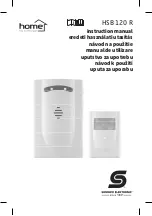
- 53 -
14
FAULT ON MAINS POWER INPUT
As a result of defects in the main power input, the unit may not be supplied with all the phases. If
L1 or L2 is missing, the control is not supplied with power and the unit fails to function. If L3 is
missing, the unit will not perform as necessary in the upper range and the arc becomes unsteady.
It is fairly easy to find interruptions by using the schematic diagram.
In addition, units may suffer a mains-side short which causes the mains protection to trip. In this
case, do not attempt to reset the automatic circuit breakers several times to power up the unit
again. In fact, mains currents of up to several 100 A flow before mains fuses trip. Currents of this
size may cause damage to other components in the unit. Also, excessive fuse ratings would
cause unnecessary subsequent defects. Before fault tracing in this area, make sure that the
mains plug is pulled!
Possible causes:
•
Short-circuit in mains cable.
•
Power rectifier defective.
•
Test: Disconnect the power rectifier, and measure.
•
Link capacitor defective.
•
Test: Disconnect the mains electrolytic capacitor. (On units capable of running on three-
phase power, two electrolytic capacitors are connected in series).
•
In most applications, a digital multimeter is adequate for testing. In isolated cases, an elec-
trolytic capacitor will not cause internal arc-over until a voltage of about 100 V is applied. To
ensure reliable testing, the power supply should be capable of supplying an adequately high
voltage.
•
Do not apply a voltage that exceeds 350 V!
CAUTION! An electrolytic capacitor charged to a high voltage carries a lot of energy. When the
tested is completed, make sure you discharge the capacitor. Do not touch the connections before
discharge.
15
TORCH BUTTON CONNECTION
When connecting the Torch button, make sure that part of the HF energy is coupled capacitively
to the torch control leads. Therefore, the Torch button connection must be adequately insulated
from the protective conductor (enclosure). Similarly, the torch control leads must be adequately
insulated from other cables.
16
WEAK INSUFFICIENT HF-IGNITION
If the needle is cold and grey (oxidised), we recommend the HF ignition while putting the gas noz-
zle in contact with the workpiece. Additionally we advice you to dip the needle once on the work-
piece to destroy the oxide on the surface of the needle before ignition.
Check that the diameter of the needle corresponds to the start-up and welding current.
If the needle is hot and the distance between needle and workpiece is not too large, there should
be no HF ignition problem with a properly functioning DTG 405.
If possible, check the HF ignition conditions and compare with another machine under the same
conditions (gas, gas flow, needle, torch, workpiece, etc.)
Summary of Contents for Aristotig 405 AC/DC
Page 1: ...0458 165 002 9910 DTG 405 Aristotig 405 AC DC Welding rectifier Service manual...
Page 9: ...9 NOTES...
Page 10: ...10 CONNECTION DIAGRAM DTG 405...
Page 11: ...11...
Page 15: ...15 NOTES...
Page 16: ...16 BLOCK DIAGRAM DTG 405 405a pcx...
Page 17: ...17 Warning Some parts of this circuit are connected to mains voltage potential 405b pcx...
Page 27: ...27 A2 COMPONENT POSITIONS a2 1b pcx a2 2b pcx...
Page 40: ...40 A9 A13 COMPONENT POSITIONS A10 A14 COMPONENT POSITIONS...
Page 62: ...62 8 WAVEFORM AC2 SMOOTH WAVE ac2 pcx...
Page 81: ...81 NOTES...
Page 91: ...page...
















































